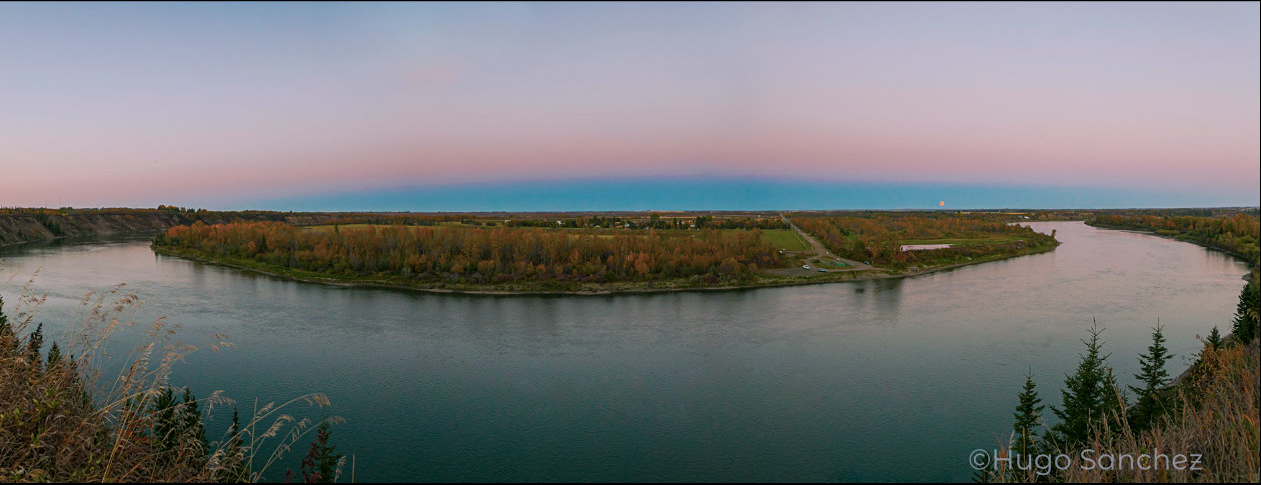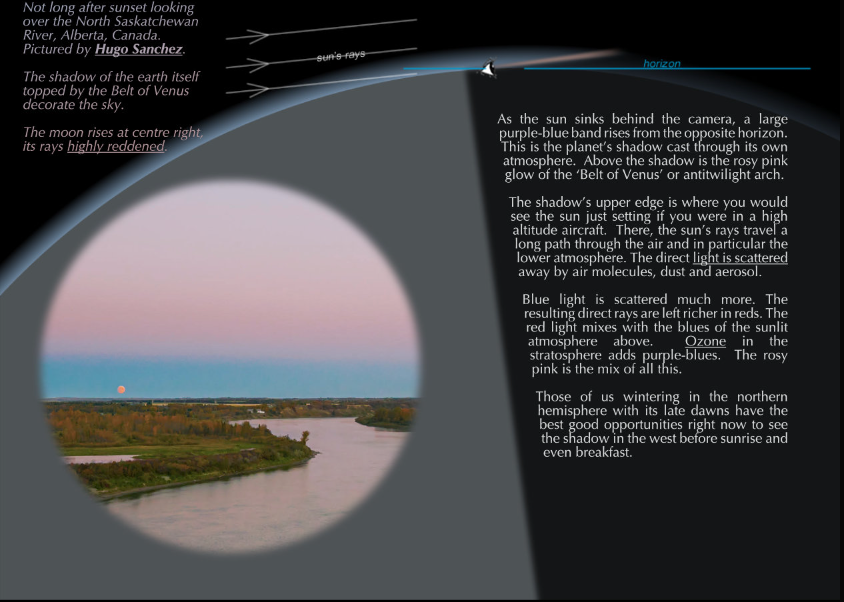Belt of Venus, Earth's Shadoe, Alberta, Canada
Belt of Venus, Earth's Shadow, Alberta, Canada: A Captivating Atmospheric Phenomenon
Have you ever witnessed a breathtaking display in the sky during the twilight hours? One such mesmerizing phenomenon is the Belt of Venus, accompanied by the Earth's shadow. In the picturesque province of Alberta, Canada, these celestial wonders paint the evening and morning skies with an ethereal beauty that captivates onlookers.
The Enchanting Dance of Light and Shadow
As the sun bids farewell to the horizon, an enchanting transformation begins to unfold. As if choreographed by nature itself, a large purple-blue band emerges from the opposite horizon, casting its ethereal glow. This is the Earth's shadow, cast through its own atmosphere. Just above the shadow lies the rosy pink arc known as the Belt of Venus or antitwilight arch.
Exploring the Earth's Shadow
The upper edge of the Earth's shadow offers a unique perspective on the setting sun. Imagine yourself soaring high in a plane, gazing out the window as the sun sinks below the distant horizon. At this altitude, the sun's rays travel through an extended path in the atmosphere, particularly through the lower layers. Along this journey, air molecules, dust, and aerosols scatter away the direct light.
The scattering process has an interesting effect on the light spectrum. While blue light scatters more easily, red light tends to persist. Consequently, the direct rays that reach our eyes are enriched with red hues. These reddened rays intermingle with the sunlit atmosphere above, resulting in a stunning blend of blues and pinks. Additionally, the presence of ozone in the stratosphere contributes shades of purple-blue to this captivating display.
The Belt of Venus: A Rosy Delight
Above the Earth's shadow lies the captivating Belt of Venus. This rosy-pink glow adds an extra touch of magic to the twilight sky. The Belt of Venus is the result of sunlight scattering and interacting with the Earth's atmosphere during the antitwilight period. This period occurs after sunset or before sunrise when the sun is below the horizon, yet its rays still illuminate the upper atmosphere.
The interplay of scattered light, atmospheric conditions, and our vantage point on Earth creates this stunning phenomenon. The mix of scattered sunlight and atmospheric particles, along with the Earth's curvature, contributes to the unique shape and color of the Belt of Venus. It is a sight that truly showcases the wonders of our planet and its atmosphere.
The Best Opportunities to Witness the Earth's Shadow and Belt of Venus
For those residing in the northern hemisphere during the winter months, nature presents an extraordinary opportunity to witness the Earth's shadow and the Belt of Venus in all their glory. As the days begin with late dawns, the twilight hours extend, allowing ample time to observe these celestial marvels.
Before sunrise, as you step outside to greet the day, cast your gaze towards the western sky. There, you may catch a glimpse of the Earth's shadow gracefully fading away, accompanied by the enchanting rosy glow of the Belt of Venus. These moments offer a serene and awe-inspiring start to your day, inviting you to embrace the beauty that surrounds us.
A Symphony of Light and Atmosphere
The Belt of Venus and the Earth's shadow in Alberta, Canada, exemplify the harmonious interplay between light and atmosphere. These phenomena remind us of the intricate mechanisms at work in our atmosphere, where light particles scatter and interact with various components. The result is a captivating symphony of colors that fills our sky during twilight.
Witnessing such celestial displays evokes a sense of wonder and curiosity about the world we inhabit. It reminds us to pause, appreciate the natural beauty that surrounds us, and marvel at the wonders of our atmosphere. The Belt of Venus and the Earth's shadow in Alberta, Canada, stand as a testament to the ever-fascinating world of atmospheric optics.

Not long after sunset looking over the North Saskatchewan River, Alberta, Canada. Pictured by Hugi Sanchez.
The shadow of the earth itself topped by the Belt of Venus decorate the sky.
The moon rises at centre right, its rays highly reddened.
 As the sun sinks behind the camera, a large purple-blue band rises from the opposite horizon. This is the planet's shadow cast through its own atmosphere. Above the shadow is the rosy pink glow of the 'Belt of Venus' or antitwilight arch.
As the sun sinks behind the camera, a large purple-blue band rises from the opposite horizon. This is the planet's shadow cast through its own atmosphere. Above the shadow is the rosy pink glow of the 'Belt of Venus' or antitwilight arch.
The shadow's upper edge is where you would see the sun just setting if you were in a high altitude aircraft. There, the sun's rays travel a long path through the air and in particular the lower atmosphere. The direct light is scattered away by air molecules, dust and aerosol.
Blue light is scattered much more. The resulting direct rays are left richer in reds. The red light mixes with the blues of the sunlit atmosphere above. Ozone in the stratosphere adds purple-blues. The rosy pink is the mix of all this.
Those of us wintering in the northern hemisphere with its late dawns have the best good opportunitoes right now to see the shadow in the west before sunrise and even breakfast.
Note: this article has been automatically converted from the old site and may not appear as intended. You can find the original article here.
Reference Atmospheric Optics
If you use any of the definitions, information, or data presented on Atmospheric Optics, please copy the link or reference below to properly credit us as the reference source. Thank you!
-
<a href="https://atoptics.co.uk/blog/belt-of-venus-earths-shadoe-alberta-canada/">Belt of Venus, Earth's Shadoe, Alberta, Canada</a>
-
"Belt of Venus, Earth's Shadoe, Alberta, Canada". Atmospheric Optics. Accessed on December 27, 2024. https://atoptics.co.uk/blog/belt-of-venus-earths-shadoe-alberta-canada/.
-
"Belt of Venus, Earth's Shadoe, Alberta, Canada". Atmospheric Optics, https://atoptics.co.uk/blog/belt-of-venus-earths-shadoe-alberta-canada/. Accessed 27 December, 2024
-
Belt of Venus, Earth's Shadoe, Alberta, Canada. Atmospheric Optics. Retrieved from https://atoptics.co.uk/blog/belt-of-venus-earths-shadoe-alberta-canada/.